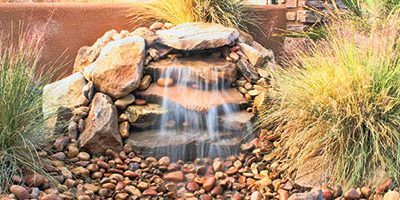Many people wish to add a custom waterfall and pool in their garden, but do not know how to accomplish it. A beautiful waterfall not only increases the appeal of your garden, but it also serves a practical purpose by adding value to your property. However, making a waterfall in tune with the surroundings is a complex task, and the experts at Rock On Walls and Falls are of great help.
If you are thinking of having a custom waterfall installed in your garden area, you can surely check with the professionals who will get the job done swiftly. There are various things to take care of while setting a natural-looking waterfall, and it will surely help if you know a thing or two about the process. Let us discuss some of the basics that you should be aware of.
1. The waterfall arrangement should complement the surroundings
The waterfall should go well with the natural terrain. If the terrain is flat, it is ideal to create the waterfall in scale with surrounding landscape by constructing a brim around the area. Ideally, smaller drops of 5 to 8 inches may be perfect, or a single drop of not more than 18 inches may help you to blend the pond and waterfall to the terrain.
2. Size of the stones must be proportionate to the drop
The drop of a waterfall is basically the distance between the exits of the water to the pond. A combination of large rocks and some small fillers rocks are required to build the setting. For example, a drop of 15 inches may use rocks of 18 inches or more in diameter to be well aligned. That is an expert’s job where the design engineers at Rock On Walls And Falls play a crucial role.
3. Appropriate framing is a must
A man made waterfall looks its best and has a ‘natural effect’ when it gets framed within the largest set of rocks. Builders place a flat surfaced stone in between these frame rocks, and as the water falls, it should hit the largest stones first and lead to the space between them. Smaller rocks and gravel are also used to fill the gaps.
4. Fewer rocks may be ideal
Do not go overboard with the number of rocks. Sometimes, the lesser stones you use, the better the waterfall arrangement looks. You can see that three to four large stones are better than 10-12 smaller stones stacked. Before planning for your artificial waterfall, try to visit some natural falls, which will help you add some realistic touches to the arrangement. In most of the natural falls, you may see one large stone surrounded by few smaller ones and the water runs through them.
5. Adding twists and turns
Well thought out twists and turns add to the overall appeal of the waterfall. The expert designers can show you several samples to see which one you like the most.
Do not be in a hurry if you are planning to build a waterfall in your backyard. Take your time and let your creativity run wild, and work in close collaboration with the expert designers and engineers to see what unique type of waterfall they can offer you.








